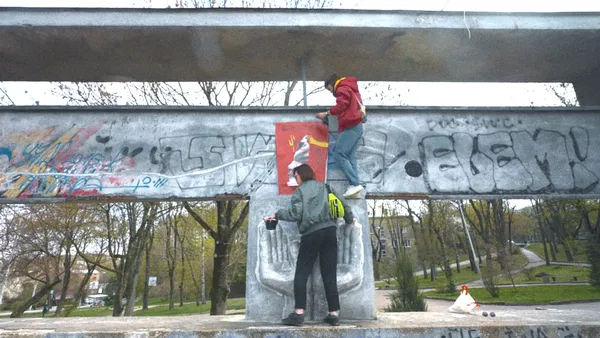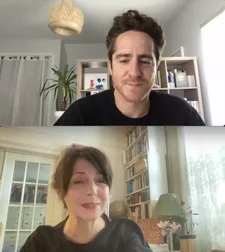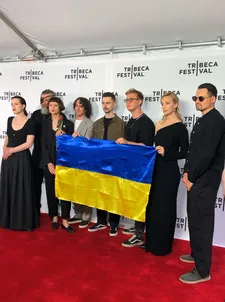David Gutnik’s creative and hopeful Rule Of Two Walls, produced by Olha Beskhmelnytsina (Ukrainian Film Academy, Board Chairwoman) and executive produced by Liev Schreiber is a take-action highlight of the 22nd edition of the Tribeca Film Festival (along with Nenad Cicin-Sain’s Kiss The Future). At the start in Lviv, Ukraine in April 2022, cinematographer Volodymyr Ivanov and sound recordist Mykhailo Zakutskyi take us to the apartment of Lyana Mytsko and Serhiy Stetsenko (aka rapper Palindrom). From there with air-raid sirens blaring we walk with Lyana to the Municipal Art Center, where she is the director, to meet artist Diana Berg from Mariupol who sees her images as “a possibility to regain some control over how beautiful it was” before the invasion on February 24, 2022. The world remembers the news footage of the bombed theatre from March 16, 2022, which had been used as a shelter and had the word “children” spelled out in Russian big enough for satellites to see.
Unlike Bernard-Henri Lévy’s documentary Slava Ukraini (which had a screening on May 4, 2023 at the United Nations to honour the invited Ukrainian soldiers), Rule of Two Walls does show faces of the dead and corpses in plain sight. A watercolour artist whose face we don’t see reflects on Easter rituals and eggs as symbols of life. She has a swing in her apartment. In Bucha a brown teddy bear sits on a swing set in front of a bombed out high-rise apartment complex.
Anton Baibakov is seen emotionally saying goodbye to his wife and little daughter as they are leaving on a train from Kyiv to hopefully safety. He becomes a Humanitarian Aid worker driving vital supplies back and forth across the country. We see Iryna Hirna and her team restoring recently discovered murals in a building and we go inside the shuttered ghost-like National Art Museum of Ukraine in Kyiv where the exhibition titled Modernism in Ukraine was abruptly halted. The artworks are packed up, with only one lonely bust remaining on display.
Volodymyr Ivanov comments that the war is “just absence of everything.” A famous Ukrainian Instagram cat named Serhiy has been rescued to Luxembourg. Serhii Petrov, aka Bob Basse, a mask maker who calls himself “a mystic and materialist” says “there are no artists in foxholes.” Spring flowers bloom on the trees amid death and destruction. Rule of Two Walls poetically ends with a little girl carrying groceries, her bike, burned-out freight train tankers, and an action both matter-of-fact and profoundly moving.
Chapter One of the film is titled Shelter and is introduced with an artwork by Andrew Lim.
During the Second World War Henry Moore was appointed “official war artist” by Kenneth Clarke, Chairman of the War Artists’ Committee. In the introduction for the book Henry Moore - A Shelter Sketchbook, the artist states on what he saw in the London Underground during an anti-aircraft barrage: “When we got out of Belsize Park we were not allowed to leave the station because of the fierceness of the barrage. We stayed there for an hour and I was fascinated by the sight of people camping out deep under the ground. I had never seen so many rows of reclining figures and even the holes out of which the trains were coming seemed to me to be like the holes in my sculpture. And there were intimate little touches. Children fast asleep, with trains roaring past only a couple of yards away. People who were obviously strangers to one another forming tight little intimate groups. They were cut off from what was happening up above, but they were aware of it. There was tension in the air. They were a bit like the chorus in a Greek drama telling us about the violence we don’t actually witness.”
In Rule Of Two Walls we hear three men sitting in a stairwell, singing beautifully an angelic chant with a young girl listening.
From outside of New Haven, David Gutnik joined me on Zoom for an in-depth conversation on Rule of Two Walls.
Anne-Katrin Titze: Nice to meet you! Where are you?
David Gutnik: I am home.
AKT: Which is New York?
DG: I’d been out of New York since the pandemic. I’m just outside New Haven, so I’m an expat. We both have a lot of books!
AKT: Yes we do. I spoke with Bernard-Henri Lévy in May.
DG: You did?
AKT: Yes, at the UN where he had his premiere of Slava Ukraini and before that I had asked him if he could plan his film at all. And he said, no, the film was structuring itself with the events. What about yours? How much could you plan day-to-day?
DG: Yeah, I think that definitely I would characterise my experience in a similar way. Obviously this is a very unique situation shooting a film during a war. This is my first documentary. I would guess whenever you’re making a documentary there’s a little bit of this going on where you have to kind of follow your nose. There’s no script, so you fly by the seat of your pants and find the story as you go. I went to Poland, to Warsaw on a one-way ticket. I thought I was going to make a film about people who left. Like my family, my parents, my sister, and grandparents as part of a prior refugee generation from Ukraine.
AKT: When did they leave?
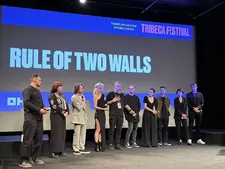 |
| Rule Of Two Walls Tribeca world première on June 8 Photo: courtesy of New City/Old City |
DG: They left in the Eighties before the fall of the Soviet Union. My sister was six when she came and I just made it, I was born in Brooklyn. So I went to Warsaw thinking I was going to make a film about refugees. Then I came across an article in the Washington Post about this Arts Center in Lviv and this woman who runs it, Lyana Mytsko. She said something to the effect of: Putin says that we don’t exist, so our art needs to prove him wrong. And the art needs to be like a gun of Ukrainian culture.
I was inspired by this and by her and I called her. I asked her what she was doing and she said “I have these old Soviet walls in my centre that we’re peeling off and we’re finding all this old Ukrainian art behind the wall.” I was like “Is somebody shooting this?” “Just photos.” “What about video?” She said “You come!” That night I got on a bus.
My producer Olha [Beskhmelnytsina],who is now the Chairwoman of the Ukrainian Film Academy, she put me on a bus and I got to Ukraine the next morning, met her at the centre, met my cinematographer Volodymyr Ivanov and my sound recordist Mykhailo [Zakutskyi]. And the rest is a blur. I just didn’t stop shooting.
AKT: The story of the walls is fascinating and you refer to this in the title, too, the history aspect and its importance. There is a moment when somebody says “people return to tradition who never embraced it before.”
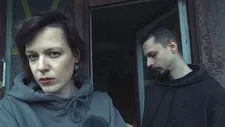 |
| Lyana Mytsko with Stepan Burban (aka rapper Palindrom) in their apartment Photo: courtesy of New City/Old City |
DG: Yeah, that’s really interesting. Where are you getting that?
AKT: It was in your second chapter. Someone is saying that.
DG: Oh right, yeah, yeah, when Lyana is speaking with the artist. Because people are looking for a way to connect.
AKT: The parallels are striking to previous wars. Sandbags! I remember seeing in 2020 the documentary Babi Yar. Context, that is entirely archival footage that premiered at Cannes. You see in Lviv, in Kiev, the people putting together the sandbags. It’s around 1939 and you have the same images for 2023.
DG: Yeah, did you speak with Sergei Loznitsa?
AKT: No, I didn’t. Do you know him?
DG: I don’t know him personally. Actually the first person I connected with in Ukraine was Serhiy Stetsenko who shot Maidan (2014), the Loznitsa documentary about the Maidan revolution. I just reached out to Serhiy saying “Hey, I’m a fan of yours, are you safe? I’m coming to Ukraine to make a film," and we started talking every night. He introduced me to Olha, my producer. He actually is also an additional cinematographer on the film, really amazing guy.
 |
| David Gutnik on Rule Of Two Walls Executive Producer Liev Schrieber: “He watched a cut and gave me some really great notes and feedback.” Photo: Anne-Katrin Titze |
AKT: How did Liev Schreiber get involved in this project?
DG: I had known that Liev was very involved; there’s so many different ways to support. There’s a lot of celebrities out and front on social media and raising money and doing incredible things. What was different about Liev was that he was going to Ukraine. Our teams kind of passed each other like ships in the night in Berdyansk.
I didn’t know that he was there but then saw videos that he was there on the same street where we were shooting. I wrote him a letter, connected with him after I came back from Ukraine. He watched a cut and gave me some really great notes and feedback. We started a little bit of a creative dialogue and once we established that and a good rapport he came onboard.
AKT: You decided not to name the people in your film with little identifier name tags. Is that partly for security reasons? For their safety?
DG: No. I think that was just part of a larger conceptual framework for the film. This is not a knock on this device or approach in other documentaries, but we just didn’t want to do those things that you see in a lot of other documentaries. Place names, lower thirds. We tried to treat the film as much as possible as we would a narrative in both the way that we shot it and the way we edited the film. Which isn’t to say that there’s anything staged or fictional that we shot.
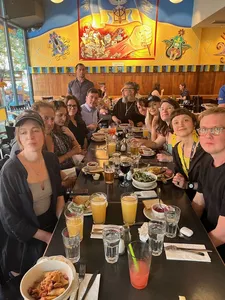 |
| Rule Of Two Walls team at Veselka in New York celebrating the 2nd Tribeca screening Photo: Susan Norget |
There was somebody who watched the film early on at a feedback screening that said - this was early on and there was a big discussion about this - “I’ve watched a lot of documentaries and I don’t have a lot of the hooks that I get to hold on to help me navigate the film.” And I liked that. Somebody said “It destabilised me, it made me feel uncomfortable, like I didn’t know where I was.”
Part of the idea is to imagine what it’s like to be in Ukraine, to be Ukrainian right now. It’s a destabilising experience. So blurring the lines between physical frontlines and psychological frontlines, between place names, doc, narrative - because they just don’t know what the day’s going to be like or whether they’re going to have a home tomorrow. I’m just also somebody who … I’m not an expert or an authority on anything, but I like movies in which a story is something you have to kind of earn and experience, as opposed to a story being kind of handed to you. So that’s why. That’s a lot of different answers.
AKT: It makes our job, who are writing about it, and taking notes while watching a film, a little bit difficult. As in: who am I talking about? So you don’t want any identifications of the people?
DG: Oh they can be identified. It was just for the viewing experience. If you would like I can provide you with names for who everyone is.
AKT: That would be very helpful, yes.
DG: Of course, I email you a list [which David did do]! Now I’m getting your question. I didn’t have to go through all of that.
AKT: No, that’s super interesting! I love how you end the film.
DG: Oh wow.
 |
| Veselka in support of Ukraine Photo: Anne-Katrin Titze |
AKT: It’s powerful. The girl, the bike, the train. I don’t want to say more than that. It’s the perfect ending.
DG: Yeah, the idea of the strength but also the reality.
AKT: Thank you for this.
DG: Thank you, pleasure. I enjoyed talking to you.
AKT: Maybe see you at Tribeca!
DG: I hope so! Thank you for taking the time and responding to the film.
The remaining screenings of Rule Of Two Walls at the Tribeca Film Festival are on Friday, June 15 at 5:15pm - AMC 19th Street and Sunday, June 18 at 8:30pm - Village East by Angelika.
The 22nd edition of the Tribeca Film Festival runs through June 18.








